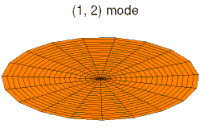
Back Vibració d'una membrana circular Catalan Vibraciones de una membrana circular Spanish Lëkundjet e membranës elastike Albanian

A two-dimensional elastic membrane under tension can support transverse vibrations. The properties of an idealized drumhead can be modeled by the vibrations of a circular membrane of uniform thickness, attached to a rigid frame. Due to the phenomenon of resonance, at certain vibration frequencies, its resonant frequencies, the membrane can store vibrational energy, the surface moving in a characteristic pattern of standing waves. This is called a normal mode. A membrane has an infinite number of these normal modes, starting with a lowest frequency one called the fundamental mode.
There exist infinitely many ways in which a membrane can vibrate, each depending on the shape of the membrane at some initial time, and the transverse velocity of each point on the membrane at that time. The vibrations of the membrane are given by the solutions of the two-dimensional wave equation with Dirichlet boundary conditions which represent the constraint of the frame. It can be shown that any arbitrarily complex vibration of the membrane can be decomposed into a possibly infinite series of the membrane's normal modes. This is analogous to the decomposition of a time signal into a Fourier series.
The study of vibrations on drums led mathematicians to pose a famous mathematical problem on whether the shape of a drum can be heard, with an answer (it cannot) being given in 1992 in the two-dimensional setting.
